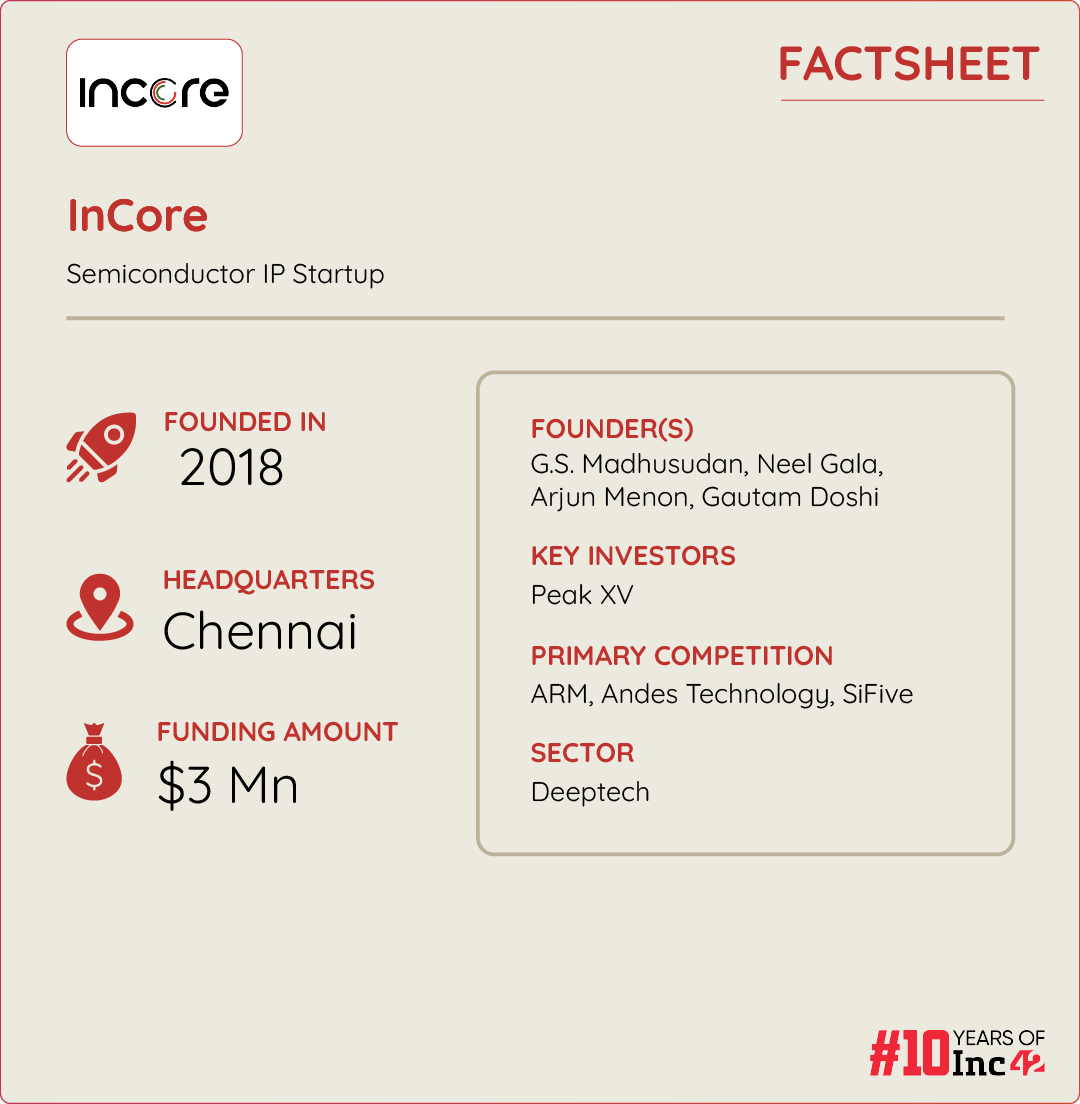For decades, the British company ARM dominated the intellectual property (IP) market in the semiconductor industry. However, the arrival of RISC-V, the open standard instruction set architecture (ISA), a few years ago, challenged ARM’s monopoly in the market, giving a much-needed shift to the global semiconductor ecosystem.
Many leading fabless design companies, such as Qualcomm and NVIDIA, and even Samsung and Google, which were earlier dependent only on SoftBank-owned ARM’s IP offerings, also started developing their own RISC-V processors for varied applications.
Back home, IIT Madras brought in a major revolution with the country’s first home-grown microprocessor, SHAKTI, which was open-source and built on top of RISC-V.
Started around 2012, the SHAKTI programme was led by current IIT Madras director, professor Veezhinathan Kamakoti, who was soon joined by G.S. Madhusudan, Neel Gala, Arjun Menon, and others.
After collaborating for several years, Madhusudan, Gala, and Menon decided to apply their insights from the SHAKTI programme to develop scalable, commercial-grade IPs. Besides, what fuelled their motivation was a growing semiconductor IP market, expected to breach the $15 Bn mark by 2032.
Realising that more semiconductor companies would need vertically integrated customisable IP cores in the not-so-distant future, given the growing market of consumer electronic devices, automotive, AI, and various computing devices, they founded InCore Semiconductors in 2018.
Today, the startup is focussed on developing semiconductor processor IPs based on RISC-V open-source architecture. Its suite of offerings can be integrated into chips for a variety of embedded applications, including wearables, smart IoT devices, PoS terminals, and more. Notably, Gautam Doshi, a seasoned industry expert, joined the initiative later.
InCore’s InceptionInCore is not a fabless chip maker, it is an IP company, which caters to system-on-chips (SoC) companies and helps them design chips as per their varied customer requirements.
For the uninitiated, in semiconductor parlance, IPs are a set of specifications, source codes, and other such information that are required to manufacture a given semiconductor.
Back to the story, after working on building the SHAKTI processor, the founders realised that scaling the programme had its challenges as there were requirements for more independent research and efforts to give it a shape that could work as a plug-and-play IP for SoC companies.
“We realised open source, beyond a point, at least in hardware, is not scalable. It has a lot of nuances and ecosystem constraints that a commercial entity, like InCore, would want to do,” cofounder and CTO, Gala, said.
However, only four years after incorporating the startup, in 2022, InCore became confident that RISC-V was there to stay as some of the top semiconductor companies started betting on the technology and the community behind it was growing.
After almost five years of staying bootstrapped, InCore bagged $3 Mn in its seed funding round from Peak XV in 2023 to make its dream a bigger reality.

Today, InCore has its own proprietary offerings, which include its Azurite and Calcite cores.
Speaking on how the startup has differentiated itself from the academic research of SHAKTI, Gala said, “We are more focussed on the productisation, getting the last mile engineering and optimisations done so that the actual processors are shippable. They address real workload, the need of the hour problems… We don’t specifically push back to SHAKTI or adopt SHAKTI beyond a particular point, rather SHAKTI has been the ground for all things that InCore is today.”
He added that despite the dependency on SHAKTI, the overlap is minimal (5-10%). The company claims to have rewritten a majority of the codes and added new processors to the offerings.
What Comprises InCore’s Core?Gala noted that when it comes to IPs, InCore has to be fab agnostic so that its SoC customers can choose any fab for the final chip manufacturing.
This also necessitated InCore to spend significant time characterising its IPs for specific target segments.
“So, we don’t build one processor at a time. What we build is a code generator or a processor generator that is configurable and customisable. From a single line of code or from the generator, you can give in a specification and say that you want the tiniest code possible, or you want a high-performance code possible, or you want a balance of them, and the generator would spit out the required IP,” Gala explained.
InCore’s Azurite is a tiny core, equivalent to that of ARM’s Cortex M0 and Cortex M4 processors. It targets applications like energy meters, smart metering systems, and smart card applications to operate at 50-250 megahertz of computing operations.
Its Calcite is a Linux capable core. Its target segments are computes that require up to 1-1.4 gigahertz of operations, which include point-of-sale terminals, wearables, and networking systems.
Currently, InCore is piloting its IP offering with a few companies in India and globally. The startup is still in the pre-revenue stage and aims to start generating revenue by the end of 2024 itself.
Meanwhile, the founders have set their eyes on keeping their product line minimal. However, this does not mean compromising on the ability to address multiple segments or providing more solutions beyond cores.
Over the last few months, InCore has also started working on other design components, such as network on chips, interconnects, and fabrics, which is expected to boost its revenue stream in the long run.
The Way Ahead For InCoreGala highlighted that the gestation period for semiconductor players is too long and for IP providers it usually takes six months to a year for any deal to materialise. This is because every process goes through a rigorous evaluation process, legal procedures, and testing.
Meanwhile, Indian semiconductor startups are faced with an uphill task of building trust in the global market. This particular issue stood out as a sore thumb when Gala and other founders were trying to raise funds.
Later, the founders understood that the semiconductor industry is beyond the comprehension of many, therefore the flow of patient capital in this ecosystem is skewed.
Despite the hurdles, the startup aims to forge ahead and is currently working on building its next core offering – Dolomite, which will be suitable for mobile devices, storage, and other high-performance embedded devices.
By mid 2025, this offering would be ready to be deployed. With this, InCore claims to be able to cover all the core offerings provided by ARM.
The startup claims to have already built a pipeline of 10-12 customers. Currently, InCore is more focussed on capturing players in the Bay area.
Also, the startup is not keen on raising funds immediately. However, it would raise another round only sometime next year to support its next level of growth after achieving a few milestones such as getting the proof of its technology on silicon chips and rolling out a few more product offerings.
With major plans on the anvil, it now remains to be seen how InCore will spearhead the country’s dream of becoming a semiconductor hub, all while working in the not-so-decorated segment of building IPs, especially when there is much attention being given to building semicon fabs and bolstering design companies in India’s semiconductor market projected to cross $150 Bn by 2030.
[Edited By Shishir Parasher]
The post How This Indian Startup Is Taking On Global Semiconductor Giants With Scalable Processor IPs appeared first on Inc42 Media.
You may also like

How to watch Man United vs Tottenham - TV channel, live stream and kick-off time

Roy Keane's unlikely reaction to his daughters having boyfriends stuns studio audience

Gary Neville calls out two Liverpool stars after 'messy' incident in Wolves win

Law and order has collapsed, jungle raj prevails in Delhi, claims Kejriwal






